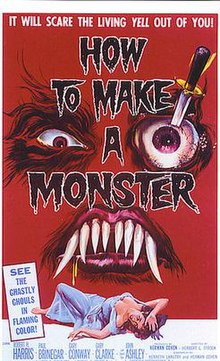
American International Pictures is an American film production company owned by Amazon MGM Studios. In its original operating period, AIP was an independent film production and distribution company known for producing and releasing films from 1955 until 1980, a year after its acquisition by Filmways in 1979.

Frankenstein's Daughter is an independently made 1958 American black-and-white science fiction/horror film drama, produced by Marc Frederic and George Fowley, directed by Richard E. Cunha, that stars John Ashley, Sandra Knight, Donald Murphy, and Sally Todd. The film was distributed by Astor Pictures and was released theatrically as a double feature with Missile to the Moon.

Samuel Zachary Arkoff was an American producer of B movies.

I Was a Teenage Werewolf is a 1957 American science fiction horror film directed by Gene Fowler Jr., and starring Michael Landon as a troubled teenager, Yvonne Lime and Whit Bissell. Co-written and produced by cult film producer Herman Cohen, it was one of the most successful films released by American International Pictures (AIP).

It Conquered the World is an independently made 1956 American black-and-white science fiction film, produced and directed by Roger Corman, starring Peter Graves, Lee Van Cleef, Beverly Garland, and Sally Fraser. It Conquered the World was released theatrically by American International Pictures as a double feature with The She-Creature.

The beach party film is an American film genre of feature films which were produced and released between 1963 and 1968, created by American International Pictures (AIP), beginning with their surprise hit, Beach Party, in July 1963. With this film, AIP is credited with creating the genre. In addition to the AIP films, several contributions to the genre were produced and released by major and independent studios alike. According to various sources, the genre comprises over 30 films, with the lower-budget AIP films being the most profitable.
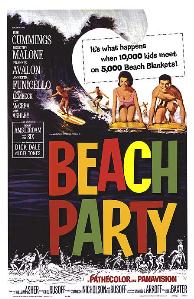
Beach Party is a 1963 American film and the first of seven beach party films from American International Pictures (AIP) aimed at a teen audience. This film is often credited with creating the beach party film genre.

The Eye Creatures is a 1967 American made-for-television comedy horror science fiction film about an invasion by a flying saucer and its silent, shambling alien occupants.

I Was a Teenage Frankenstein is a film starring Whit Bissell, Phyllis Coates and Gary Conway, released by American International Pictures (AIP) in November 1957 as a double feature with Blood of Dracula. It is the follow-up to AIP's box office hit I Was a Teenage Werewolf, released less than five months earlier. Both films later received a sequel in the crossover How to Make a Monster, released in July 1958. The film stars Whit Bissell, Phyllis Coates, Robert Burton, Gary Conway and George Lynn.
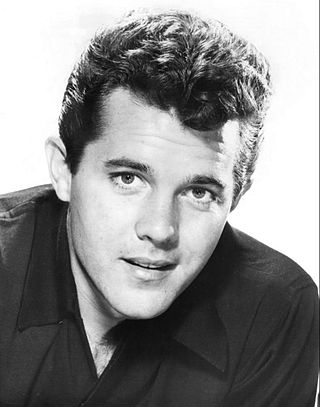
John Ashley was an American actor, producer and singer. He was best known for his work as an actor in films for American International Pictures, producing and acting in horror films shot in the Philippines, and for producing various television series, including The A-Team.
James Harvey Nicholson was an American film producer. He is best known as the co-founder, with Samuel Z. Arkoff, of American International Pictures.
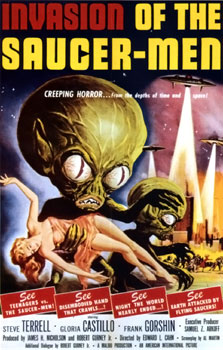
Invasion of the Saucer Men, is a 1957 black-and-white comic science fiction/comedy horror film produced by James H. Nicholson for release by American International Pictures. The film was directed by Edward L. Cahn and stars Stephen Terrell, Gloria Castillo, Raymond Hatton and Frank Gorshin.

Day the World Ended is a 1955 independently made black-and-white post-apocalyptic science fiction film, produced and directed by Roger Corman, that stars Richard Denning, Lori Nelson, Adele Jergens, Paul Birch (actor) and Mike Connors. Chet Huntley of NBC, later of The Huntley-Brinkley Report, served as the film's narrator. It was released by American Releasing Corporation as a double feature with The Phantom from 10,000 Leagues.

Lawrence Stewart "Larry" Talbot, also known as The Wolf Man, is a title character of the 1941 Universal film The Wolf Man and its sequels, created by Curt Siodmak. He was portrayed by Lon Chaney Jr. In the 2010 remake of the film, he is portrayed by Benicio del Toro. The Wolf Man was part of the Universal Classic Monsters ensemble.

The She-Creature, or The She Creature, is a 1956 American black-and-white science fiction horror film, released by American International Pictures from a script by Lou Rusoff. It was produced by Alex Gordon, directed by Edward L. Cahn, and stars Chester Morris, Marla English and Tom Conway, and casting Frieda Inescort and El Brendel in smaller roles. The producers hired Marla English because they thought she bore a strong resemblance to Elizabeth Taylor.

Apache Woman is a 1955 American Western directed by Roger Corman and starring Lloyd Bridges. It was Corman's second film as director, following Five Guns West. It was one of four Westerns he made for American International Pictures, the other being Five Guns West, The Oklahoma Woman (1955) and Gunslinger (1956). Corman says Apache Woman and Oklahoma Woman were from ideas by AIP whereas the others were his ideas. This was the first film from Golden State Productions, a company headed by Alex Gordon.
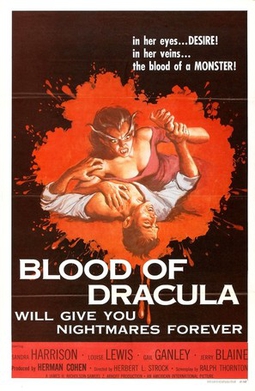
Blood of Dracula is a 1957 American black-and-white horror film directed by Herbert L. Strock, and starring Sandra Harrison, Louise Lewis and Gail Ganley. It was co-written by Aben Kandel and Herman Cohen.

Cat Girl is a 1957 British horror film directed by Alfred Shaughnessy and starring Barbara Shelley, Robert Ayres, and Kay Callard. It was produced by Herbert Smith and Lou Rusoff. The film was an unofficial remake of Val Lewton's Cat People (1942). In the United States American International Pictures released Cat Girl on a double bill with The Amazing Colossal Man (1957).

Dragstrip Girl is a 1957 film starring John Ashley in his first lead role. American International Pictures released the film as a double feature with Rock All Night and it proved an early success for the studio.

Paul Blaisdell was an American painter, sculptor and visual effects creator, best remembered for his work in science fiction and horror B movies of the 1950s.
